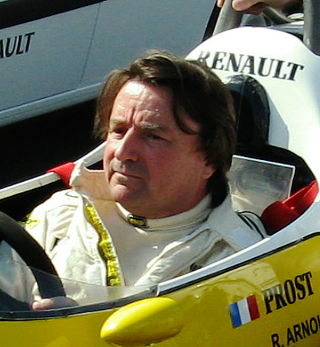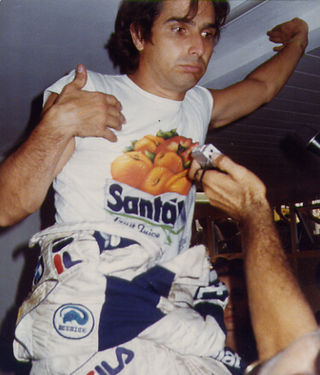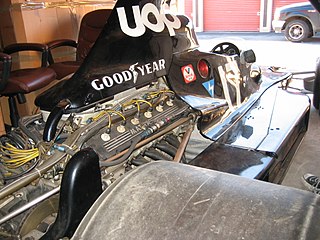
René Alexandre Arnoux is a French former racing driver who competed in 12 Formula One seasons. He participated in 165 World Championship Grands Prix winning seven of them, achieving 22 podium finishes and scoring 181 career points. His best finish in the World Drivers' Championship was third in 1983 for Ferrari. In 1977, Arnoux won the European Formula Two Championship. In 2006 he raced in the inaugural season of the Grand Prix Masters series for retired F1 drivers.

The 1983 FIA Formula One World Championship was the 37th season of FIA Formula One motor racing. It featured the 1983 Formula One World Championship for Drivers and the 1983 Formula One World Championship for Constructors, which were contested concurrently over a fifteen-race series that commenced on 13 March and ended on 15 October. Nelson Piquet won the Drivers' Championship, his second Formula One title and the first to be won by a driver using a turbocharged engine, while Ferrari won the Constructors' Championship. It was also the last Drivers' Championship won by a Brabham driver.

Stefan Nils Edwin Johansson is a Swedish racing driver who drove in Formula One for both Ferrari and McLaren, among other teams. Since leaving Formula One he has won the 1997 24 Hours of Le Mans and raced in a number of categories, including CART, various kinds of Sports car racing and Grand Prix Masters.
Motori Moderni was a Formula One engine manufacturer from 1985 through 1987. It was established by the experienced Italian engine designer Carlo Chiti.
Italian motor manufacturer Alfa Romeo has participated many times in Formula One. It currently participates as Alfa Romeo F1 Team Stake while being operated by Sauber Motorsport AG. The brand has competed in motor racing as both a constructor and engine supplier sporadically between 1950 and 1987, and later as a commercial partner since 2015. The company's works drivers won the first two World Drivers' Championships in the pre-war Alfetta: Nino Farina in 1950 and Juan Manuel Fangio in 1951. Following these successes, Alfa Romeo withdrew from Formula One.

The 1983 Race of Champions was a non-championship Formula One race held at Brands Hatch on 10 April 1983. Contested over 40 laps, it was the final non-championship F1 race to be held in the sport's history. Reigning World Champion Keke Rosberg won in a Williams-Ford, narrowly beating the Tyrrell-Ford of F1 rookie Danny Sullivan, while 1980 World Champion Alan Jones was third in an Arrows-Ford.
Gérard Ducarouge was a French Formula One car designer whose career in motorsport started in 1965 when he joined Equipe Matra Sports. His Matra MS80 car, entered by the privateer Matra International team of Ken Tyrrell, won both the Drivers' Championship and Constructors' Championship in the 1969 season. He also designed cars for Ligier and Lotus which won several races in the 1970s and 1980s.

Équipe Ligier is a motorsport team, best known for its Formula One team that operated from 1976 to 1996. The team was founded in 1968 by former French rugby union player Guy Ligier as a sports car manufacturer.

The Ligier JS5 was the first Formula One racing car made by Ligier. Designed by Gérard Ducarouge, it competed in the 1976 Formula One season, gaining 20 points and getting sixth place overall in the Constructor's Championship. The car also gave its driver Jacques Laffite and Ligier their first ever pole position at the 1976 Italian Grand Prix at Monza.

The Lola THL1 was a Formula One racing car designed by Neil Oatley for Team Haas (USA) Ltd. during four of the last five races of the 1985 Formula One season. The car used the 750 bhp, turbocharged Hart 415T Straight 4 engine. The Haas Lola team only had one car for 1985 and it was driven by 1980 World Champion Alan Jones, who was making a full-time comeback to Formula One at the age of 39.

The Tyrrell 015 was a Formula One car designed for Tyrrell Racing by Maurice Philippe for use in the 1986 season. The cars were powered by the turbocharged Renault EF15 V6 engine which was rated at 850 bhp in race trim. The 015 ran on Goodyear tyres and were driven by Martin Brundle in his third season with the team, and Philippe Streiff who joined from Ligier.

The Ligier JS29 was a Formula One car designed by Michel Têtu and Michel Beaujon for the Ligier team for use in the 1987 season. It was originally developed for use with an Alfa Romeo turbo power plant but prior to the start of the season, Ligier lost the use of the engine. The car had to be re-designed around a Megatron Straight 4 turbo engine. Redesignated the JS29B, it scored a single point during the season when driver René Arnoux finished 6th in the Belgian Grand Prix. Later in the season, the car was further refined to a JS29C specification.
The Ligier JS31 was a Formula One car designed by Michel Têtu and Michel Beaujon for the Ligier team for use in the 1988 Formula One season. It was powered by the new, normally aspirated, 3.5L Judd CV V8 engine and, like the rest of the F1 grid in 1988, ran on Goodyear tyres. Drivers for the team were French veteran René Arnoux in his 3rd season driving for team boss Guy Ligier, and Swede Stefan Johansson who had finished 5th in the World Championship with Ferrari in 1986 and 6th with McLaren in 1987. Johansson joined the team late in the off-season in place of Christian Danner, who had originally signed to drive but was unable to fit in the car comfortably.
The Ligier JS25 was a Formula One car designed by Michel Beaujon and Claude Galopin for use by the Ligier team during the 1985 Formula One season. Like its predecessor, the JS23, the JS25 was powered by a turbocharged Renault V6 engine although the car ran on Pirelli instead of Michelin tyres after the French company pulled out of Grand Prix racing at the end of 1984. Drivers of the car were initially their 1984 driver Andrea de Cesaris and veteran Jacques Laffite who returned to the team after two fruitless years at Williams, but after a series of crashes, de Cesaris was fired by team boss Guy Ligier and replaced by Philippe Streiff.

The Shadow DN7 was a Formula One car used by the Shadow team in two races late in the 1975 Formula One season. Driven by Jean-Pierre Jarier, it never finished a race.

The Ligier JS33 was a Formula One car used by the Ligier team during the 1989 Formula One season. Its best finish in a race was fifth, at the 1989 Canadian Grand Prix. The JS33 was updated to a 'B' spec for use in the following season, but failed to score any points for the team.
The Ligier JS9 was a Formula One racing car manufactured and raced by Ligier during the 1978 Formula One season. Driven by Frenchman Jacques Laffite, its best finish was third (twice).
The ATS D1 was a Formula One racing car manufactured and raced by the ATS Racing Team for the last two races of the 1978 Formula One season. It was powered by a Cosworth DFV V8 engine. Driven by Keke Rosberg, the D1 failed to finish any races in the points.

The Ligier JS19 was a Formula One racing car manufactured and raced by Équipe Ligier during the 1982 Formula One season. Powered by a Talbot-badged Matra V12 engine, the JS19 was driven by Jacques Laffite and Eddie Cheever.

The Ligier JS17 was a Formula One car designed by Gérard Ducarouge and Michel Beaujon for use by the Ligier team during the 1981 season. Powered by a Talbot-badged Matra V12, the JS17 was driven to two Grand Prix wins by Jacques Laffite. It was updated to JS17B specification for the 1982 season until it was replaced later that year by the JS19.












